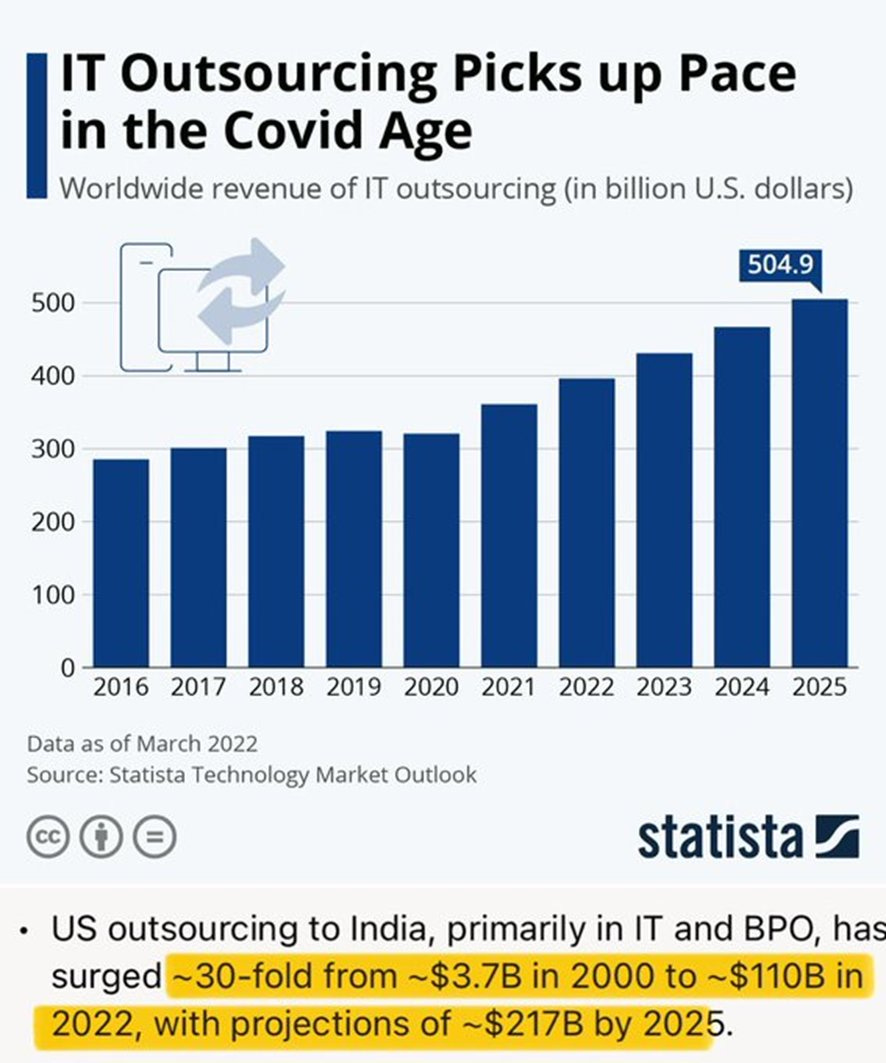US Lost 4 Million Tech Jobs to India—China 2.0
India's Not Coming for Our Factories, They Want Our Technology
President Trump blasted India with 50 percent tariffs. The full force of these tariffs will come into effect on August 27, 2025.
President Trump’s instincts are spot on: India is on the verge of becoming China 2.0.
Unfortunately, the tariffs will do little to stop this. Why?
Because India isn’t coming for our manufacturing. They’re coming for our technology sector—and they’ve been remarkably successful both at scooping up jobs, and flying under the radar.
Consider that America lost roughly 5 million jobs to China since 2001. During the same period, America lost up to 4 million technology jobs to India. Not only that, but India now has access to sensitive American technology and information. This is America’s silent national emergency.
If we are serious about reshoring American industry, then tariffs on Indian products won’t cut it. We should also tariff Indian services.
Made in Mumbai
India’s technology industry is bustling. In 2024, technology made up approximately 7 percent of India’s GDP. The industry employs 5.4 million people, and added 126,000 new jobs last year alone. Revenue was up 5.1 percent year-over-year.
Technology is transforming India—cities like Bangalore boast newly minted billionaires and skyscrapers. Meanwhile, technology employment in many major American cities, like Boston, is stagnating.
Bangalore is booming. Boston is becoming a bust. What’s going on?
One word: offshoring.
Increasingly, American companies are moving their production of digital services to India. Why? Because Indian labor is cheap. Consider that the average American technology worker earns $110,000 per year. Meanwhile, their Indian counterparts earn about $32,000—Indians work for one-third the price.
Why hire an American when you can hire an Indian to do the same job, for a fraction of the price?
Offshoring explains the rapid growth of India’s technology sector. Consider that 80 percent of India’s technology revenue comes from exports. This is a far higher fraction of export-reliant growth than we saw with China in 2001!
Interestingly, America's trade deficit in services with India was fairly small, just $3.2 billion. This gives the false impression offshoring is not a problem. However, this is not the case. In reality, the scale of offshoring is obscured by the fact that Indian services—which are largely “branch plants” of American technology companies—also service non-American markets.
Accordingly, America’s technology giants have the potential to earn large profits by offshoring production to India. Likewise, India’s government benefits from the tax revenue, and Indian people benefit from new jobs. But where do the American people factor into this equation? As usual, they don’t. This is yet another example of Wall Street screwing-over ordinary Americans.
The Price of a Rupee
As I explain my book Reshore: How Tariffs Will Bring Our Jobs Home & Revive the American Dream, offshoring hurts American workers in two main ways. First, it relocates American jobs abroad, causing unemployment. Second, it causes wage-stagnation in the economy at large. Third, it reallocates educational investment from the United States to India.
How many technology jobs have been lost to India? Although the exact number is impossible to calculate, we can estimate. A good starting point is to look at the number of Indian jobs supported by American money.
Remember, 5.4 million Indians work in the technology sector, and 80 percent of the revenue comes from exports—mostly purchased by the United States.
If we assume a one-to-one corollary between an Indian job and an American job, then we can guess that 4.3 million jobs have been displaced. In reality, this is probably too generous—Americans are more productive than their Indian counterparts. Either way, the number of lots jobs are in the millions.
This drives down wages for other workers. How? First, people who have lost their jobs due to offshoring compete with others for jobs. This increases the domestic labor supply, lowering the price of labor.
More importantly, it is quite easy to relocate services to India. This pits American workers in direct competition with workers in India—who are willing to do the same work for a fraction of the price. A globalized labor market is a race to the bottom, which is bad for American workers because they have the furthest to fall.
Lastly, there is a hidden cost to technology offshoring. Offshoring reduces the demand for skilled labor in America, and increases it in India. This creates the perverse incentive to invest in education abroad, while at the same time neglecting our own schools—it’s not only cheaper to hire Indians, it’s also cheaper to train them.
The proof is in the pudding. In 2004, 51,000 Americans graduated with computer science degrees, and 4,000 with degrees in software engineering. By 2024, these numbers had doubled to approximately 100,000 and 8,000 respectively. Not bad.
However, let’s compare this to India—which has a much smaller technology industry, and which is only entirely dependent on American investment. In 2004, 80,000 Indian students graduated with computer science degrees, and 5,000 with degrees in software engineering. By 2024, these numbers had tripled to over 250,000 and 15,000 respectively.
India now trains more people for the technology industry, and the number of graduates is increasing faster. This difference is partly explained by the fact that American technology companies demand educated Indians, rather than educated Americans. This is why major American technology companies pour money into Indian universities.
The United States has been pillaged for decades. The inability to manufacture basic goods is an existential threat to the Nation. The same is increasingly true of technology services: Americans are taking the back seat in education, employment, and innovation.
President Trump’s instincts on tariffs area correct, but the reality is that tariffs are akin to fighting last year’s war with India. We need to tariff offshored services, or tax the wages paid to foreigners so that there is no cost advantage to hiring Indians (or anyone else). If not, America will depend on foreigners for goods and services—and there will be nothing left at home.





